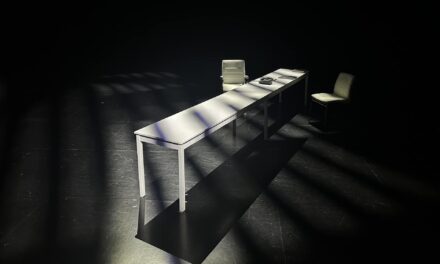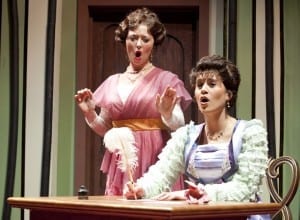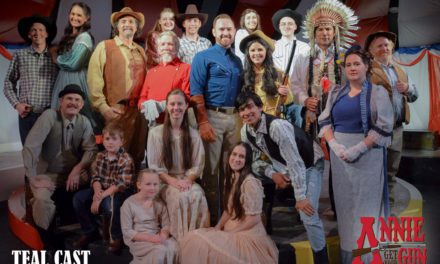 OREM—Funny Girl premiered on Broadway in March, 1964 and played for 1,348 performances. It’s the show that made Barbra Streisand a star and features some of the most loved Broadway anthems. The show follows the story of Fanny Brice, the unlikely Broadway-hopeful who rose to fame in the early part of the 20th century, and chronicles her love affair with businessman and con artist Nick Arnstein. It is a tremendous undertaking for any theater to produce, due in part to the standard set by the original production and subsequent film adaptation in 1968, which perhaps is the reason why the 2012 production will be the show’s first Broadway revival. The SCERA Shell provides audiences with a unique opportunity to participate in an entertaining evening of classic theater—but not without a few technical drawbacks.
OREM—Funny Girl premiered on Broadway in March, 1964 and played for 1,348 performances. It’s the show that made Barbra Streisand a star and features some of the most loved Broadway anthems. The show follows the story of Fanny Brice, the unlikely Broadway-hopeful who rose to fame in the early part of the 20th century, and chronicles her love affair with businessman and con artist Nick Arnstein. It is a tremendous undertaking for any theater to produce, due in part to the standard set by the original production and subsequent film adaptation in 1968, which perhaps is the reason why the 2012 production will be the show’s first Broadway revival. The SCERA Shell provides audiences with a unique opportunity to participate in an entertaining evening of classic theater—but not without a few technical drawbacks.
An outdoor theater offers any cast with variables that are somewhat unusual. The size of the Shell stage is, first of all, difficult to fill, in spite of large sets and a pretty large cast. It is a literal uphill battle to project to an audience potentially sitting remarkably far away, who are also distracted by piles of blankets, children rolling down hills, and members of their parties whom they are inclined to speak to throughout the performance. A slow sunset does not give an audience an immediate sense of reverence as lowered houselights typically do, to say nothing of natural elements—such as wind—which audience and cast alike must endure. Unfortunately, I found each of these challenging for Funny Girl to overcome. Funny Girl is a big show in itself, requiring high energy and commitment to actors in any smaller theater, which makes it even more difficult to execute in a venue with so many additional demands.
Essentially, this is a good show. The cast features solid vocals, in solos as well as a powerful ensemble. Shawn Mortensen’s choreography is fun and well-executed; it fills the space and is nicely reminiscent of the era. Director Jennifer Reed is clearly interested in humanizing Fanny, making her not so ridiculous or over the top as much as she is passionate, headstrong, and willful. The ensemble support leading characters well, and the cast is lead by some strong talent. My general qualm is that this simply may have not been the best show to produce in this particular space.
One of the biggest challenges was the lack of stage lighting for the better part of the first act. Though the performance starts at 8PM to try to allow for as much natural light to fade, the fact is that much magic is lost without the shiny stage lighting to highlight the “show within the show.” For example, “His Love Makes Me Beautiful” is staged to reflect the grand Ziegfeld Follies numbers of the time, with glitzy costumes and choreography. The sparkle is completely lost at dusk, too bright to light the scene effectively and dark enough to de-glamorize the number. It’s a particular shame since Shawn Mortensen could positively shine as the Ziegfeld Tenor—and his vocals certainly do—but his feature is somewhat lost due to the inability to spotlight. Stage lights could also be as strong conceptual choice to underscore Fanny’s daydreams about Nick Arnstein or hopes to be the “greatest star.” Lack of change in lighting actually becomes a bit of a problem as individual scenes end and actors escape the stage out of character. While lighting does resolve after the sun sets, it is disappointing in the meantime.
Sound was also an issue, with the track cutting out in the middle of the first big number (covered nicely by Brock Kannan as Eddie), and various mic problems—though wind blowing into mics is certainly something that cannot be prevented in a windy amphitheater. I also struggled a little with the costume design by Kelsey Seaver. While the costumes were pretty and fit each character nicely, it was difficult to decide during which decade the show was taking place. The Ziegfeld Follies did run from 1907 to 1931, but knee-length dresses in varying styles throughout the show do not particularly recollect pre- and post-World War I America.
That said, I absolutely commend the cast for their commitment to the show, especially in the face of blustery wind, cold temperatures, and impending rain. Delayne Dayton (Mrs. Brice), Camee Faulk (Mrs. Strakosh), Heather Burgess (Mrs. O’Malley), and Cathy Frisby (Mrs. Meeker) nicely set the tone for the show with their poker game and really help to ground the audience in the world where Fanny Brice is from. Bethany Simmons as Fanny is certainly impressive. Her vocals are spot on as she reflects but does not copy Barbra Streisand’s memorable performance; her accent is nicely subtle and unobtrusive. I confess there were moments when I wanted Simmons to demand more control of the stage, especially during what may be considered the song in the show, “Don’t Rain on My Parade.” While she is vocally stunning, Simmons lacks that grit and determination which makes the song so famous. However some of that unfocus may be readily attributed to a painfully slow tempo in the track and odd staging. Simmons is funny, lovely, and loveable, just as she should be.
Richard Losee as Nick Arnstein does exude a certain charm that does not make Fanny’s attraction completely unfounded, though his physicality and emotional levels read as somewhat stoic. Contrasted by Brock Kannan, who is warm and easily the most energetic of the cast, it is easy to wonder what exactly Fanny sees in Nick aside from his good looks and deep pockets. Luckily, that does seem to be the point, since the end of their relationship is actually quite heartbreaking.
In spite of technical problems emphasized by inclement weather, Funny Girl features a cohesive cast who do create a memorable show. Move the same production inside at SCERA, and the production may have found much more, deserved success.




